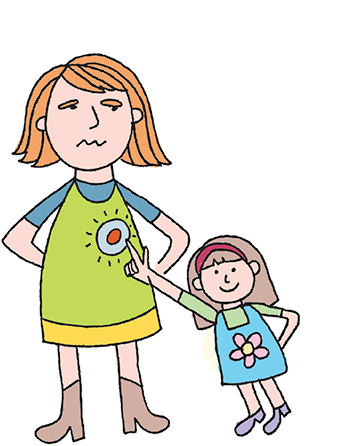
Power struggles create distance and hostility instead of closeness and trust. Distance and hostility create resentment, resistance, rebellion (or compliance with lowered self-esteem). Closeness and trust create a safe learning environment. You have a positive influence only in an atmosphere of closeness and trust where there is no fear of blame, shame or pain.
Strategies for Avoiding the Power Struggle
I have never seen a power drunk child without a power drunk adult real close by. Adults need to remove themselves from the power struggle without winning or giving in. Create a win/win environment. HOW? The following suggestions teach children important life skills including self-discipline, responsibility, cooperation and problem-solving skills—instead of "approval junkie" compliance or rebellion.
- Decide what you will do. "I will read a story after teeth are brushed." "I will cook only in a clean kitchen." "I will drive only when seat belts are buckled." (I will pull over to the side of the road when children are fighting.)
- Follow Through. The key to this one and all of the following is KINDNESS AND FIRMNESS AT THE SAME TIME. (Pull over to the side of the road without saying a word. Children learn more from kind and firm actions rather than words.)
- Positive Time Out. Create a "nurturing" (not punitive) time out area with your child.
- Distraction for Young Children and lots of supervision. Punishment decreases brain development. Children are often punished for doing what they are developmentally programmed to do—explore. (Please read Positive Discipline for Preschoolers.)
- Get children involved in the creation of routines (morning, chores, bedtime). Then the routine chart becomes the boss.
- Ask what and how questions: "How will we eat if you don't set the table?" "What is next on our routine chart?" "What was our agreement about what happens to toys that aren't picked up?" "What happened?" "How do you feel about what happened?" "What ideas do you have to solve the problem?" (This does not work at the time of conflict, nor does it work unless you are truly curious about what you child has to say.)
- Put the problem on the family meeting agenda and let the kids brainstorm for a solution.
- Use ten words or less. One is best: Toys, Towels, Homework. (Sometimes these words need to be repeated several times.)
- Encourage cooperation. Say, "I can't make you, but I really need your help."
- No words: Use pantomime, charades, or notes. A loving "nice try" look.
- Non-verbal signals. These should be planned in advance with the child. An empty plate turned over at the dinner table as a reminder of chores that need to be completed before dinner; a sheet over the television as a reminder that homework needs to be done first or that things need to be picked up in the common areas of the house.
- Use reflective listening. Stop talking and listen. Try to understand not only what your child is saying, but what she means.
- Limited choices: "Do you want to do your homework before dinner or after dinner?" "Do you want to set the table or clean up after dinner?"
- Make a "Wheel of Choice" together. Draw a big circle and divide into wedges. Brainstorm lots of solutions to problems. Draw illustrations for each solution. During a conflict, invite child to pick something from the wheel.
- Create a game: Beat the clock or sing songs while getting chores done.
- Do it WITH them. You may even want to go to the positive time out area with them.
- Use your sense of humor: Here comes the tickle monster to get little children who don't pick up their toys. This creates closeness and trust and can be followed by one of the above.
- HUGS! HUGS! HUGS! A hug is often enough to change the behavior—theirs and yours.


